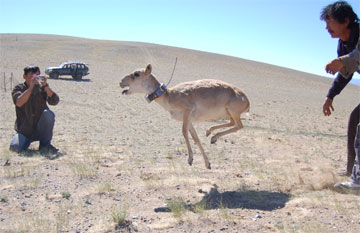Leaping Saiga! Population of bizarre Mongolian antelope plunges 95% in 15 years
Leaping Saiga! Population of bizarre Mongolian antelope plunges 95% in 15 years
WCS
October 19, 2006
A group of scientists led by the New York-based Wildlife Conservation Society (WCS) working in Mongolia’s windswept Gobi Desert recently fitted high-tech GPS (Global Positioning System) collars on eight saiga antelope in an effort to help protect one of Asia’s most bizarre-looking — and endangered — large mammals.
Standing just under two feet at the shoulder and weighing about 50 pounds, the most striking feature of the saiga is its large nose, or proboscis, similar to a tapir. The function of this unusual nose is not clear, but it may serve to warm or filter air during Mongolia’s frigid winters and notorious dust storms.
Today saiga numbers have plummeted by 95 percent from an estimated one million animals just 15 years ago, due to poaching for Chinese medicines and competition with livestock. In an effort to safeguard remaining populations, WCS, along with the Mongolian Academy of Sciences and support from the National Geographic Society, have embarked on this study to better understand the needs of these unusual ungulates and how best to protect them.

A rare saiga antelope just fitted with a high-tech Global Positioning System collar in Gobi Desert of Mongolia. Photo: Joel Berger/Wildlife Conservation Society |
“The GPS collars will provide information on movements of saigas across this dazzling but arid landscape so that a more comprehensive conservation strategy can be developed to assure the persistence of this little known species” said WCS research scientist Kim Berger, a co-director of the study.
Saigas still occur in pockets of Uzbekistan, Turkmenistan, Kalmykia, Kazakhstan, and Mongolia, but the genetically unique subspecies found only in Mongolia numbers perhaps less than 2,000. Ten thousand years ago saigas roamed from the northern Yukon and Alaska to England, but the species was lost from North America and Britain as climate and vegetation shifted. With the collapse of the Soviet Empire, unregulated hunting resulted in the recent startling decrease in saiga numbers.
“Although Mongolia faces stiff conservation challenges as it transitions to a free-market economy, the saiga can easily emerge as a success story with a little scientific input and support for local communities” offers Joel Berger, project co-director and Senior Scientist with the Wildlife Conservation Society.
“We must take immediate actions to protect habitat and stop and poaching for saiga horns, while improving the conditions and resources of park rangers who are spending their valuable time to protect this unique species,” said Lhagva Lkhagvasuren of the Mongolian Academy of Sciences “Otherwise, we will have only an empty steppe and deserts with no any saiga. Future generations will never forgive us for our carelessness.”
This is a modified news release from WCS







